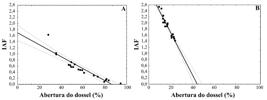ABSTRACT
The forest formations on quartz white-sand are a kind of oligotrophic ecosystem and its phytophysionomical characteristics are affected by the climate seasonality. The canopy is one of these characteristics, its variations may influence the spatial distribution of the energy in the environment. The objective of this research was to evaluate and compare the tree density and the seasonality change on the canopy openness on habitats of white-sand in Serra de Itabaiana National Park. The data were collected in two environments: gaping vegetation of white-sands strictu sensu (VA) and closed vegetation of riparian forest (MR). To estimate tree density, it was utilized the wandering-quarter, where trees with CAP > 5cm were sampled. To evaluate the canopy dynamics, the transects had 5 points equidistant 20m, ten per environment. Hemispherical pictures were taken in January (dry season) and June (wet season), utilizing a digital camera with a fisheye lens. The images were analyzed on the Gap Light Analyzer software. The results showed that riparian forest have higher tree density (498 ind ha-1) than the opened (296 ind ha-1). The letter do not showed variations in the canopy openness (t = -2,0052; p > 0,05) or in Leaf Area Index (t = -2,0052; p > 0.05) between wet (52,24% ± 18,13% e 0,68 ± 0,45) and dry seasons (67,39% ± 15,38% e 0,36 ± 0,23). In riparian forest, the canopy openness (t = 7,1739; p < 0.05) and LAI values (t = -5,1609; p < 0.05) vary between wet (13,70% ± 2,24% e 2,13 ± 0,23) and dry (21,08% ± 2,36% e 1,63 ± 0,20) seasons showing the seasonality. Differences between the two habitats highlights the environmental heterogeneity in Serra de Itabaiana and show that forest formations on white-sand respond by different ways to the water seasonality of this ecosystem. Because it is located in an ecotone area between evergreen forest and forest Semideciduous, the riparian forest tends to lose some of their leaves during the dry season. Moreover, the distribution pattern of the plants can contribute to the differences between the studied habitats.
Keywords:
opening the canopy; hemispheric photos; leaf area index; gaping vegetation; riparian forest.

 Thumbnail
Thumbnail
 Thumbnail
Thumbnail
 Thumbnail
Thumbnail
 Thumbnail
Thumbnail
 Thumbnail
Thumbnail




